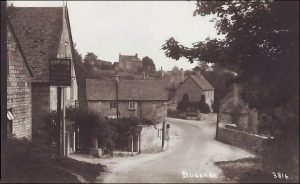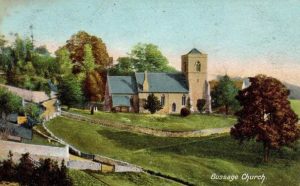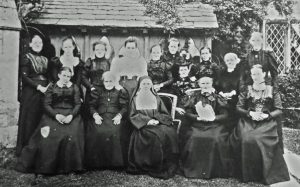The village of Bussage has witnessed substantial growth over many years since first recorded as Bysrugg in 1304. Over the intervening years various other spellings have appeared – Byserugge (1354), Bussrige (1586), Byssridge (1598) and Bissridge (1601) just some examples. Even after the current spelling appeared in 1685 there were still other variants in use, notably Bushage (1729) and Bussige (1722). The meaning of the name has been variously discussed and described, the two most common explanations suggesting it derives from ‘the ridge of does’ or ‘the ridge of Bissa’. Allowing for the propensity of wildlife, in particular the deer that still today roam the surrounding fields and woodlands, the first such interpretation feels somehow appropriate.
The tything of Bussage originally included Eastcombe (Isscombe or Esscombe – the combe of the ash tree) and stretched as far south as Black Ness to the Stroud Valley. Bisley Common extended to Brownshill and bounded the east side, with Todsmore stream marking the West. It was a thickly wooded area, of which Frith Wood is a small remaining part. Whilst today viewed more as an adjacent hamlet, the majority of the earliest inhabitants of the village lived in Todsmore (the moor of the foxes), today Toadsmoor. The earliest mention of a Bussage inhabitant occurred with the naming of William of Bysrugg in 1304, but it was not until 1589 that there is mention of any property as such, namely that of Horshalls ‘lying in Busridge’. The Rogers family appear in many records for the area from 1678 through to the mid 1700s and appear to have been well established in Bussage, primarily in Toadsmoor.
Many of those living in the village worked at the mills built along the Chalford valley. The village itself had several nearby in the Toadsmoor valley on the banks of the stream that flows down from Bisley, through Bismore and the Fishponds before joining the Frome at Bourne. Indeed the earliest mention of a mill on this site dates from 1592. The main group of three mills, collectively known as Toadsmoor Mills, stood close together below the point where a track crossed from Bussage into Nether Lypiatt. Over many years they were engaged in various different services (fulling-mill and grist-mill originally) until 1690 when they passed to William Hayward, a clothier. Much later in 1863, they were leased to Charles Freeman and Richard Davis, shoddy and mill-puff manufacturers of Bristol. From 1885 through to the 1930s William Selwyn was making flock and shoddy at the mill, which by this time comprised two buildings on the west side of the Bussage-Bourne road and another, Shortwood Mill, on the east side of the road. Flock and shoddy mills produced a cheap cloth (often considered poor quality – hence shoddy) by shredding cloth and woollen rags into fibres, grinding them down and mixing in small amounts of new wool to produce an affordable cloth material.
Few houses in Bussage appear to be dated, with the aptly named The Old House (1704 – originally the home of a broad weaver, with farming land attached) considered to be the oldest. Of another well-known property, Bussage House, there is little known of its origins save that there was a mortgage on it in 1826. Enlarged from more humble origins in the 19th century by ‘Squire’ William Davis, he added a large room to the rear and obtained a licence to use it as a Nonconformist Meeting Room. It later passed into the possession of John Sibree, who made further additions to the building and established it as a boys’ school. In the early 1900s the Boys school moved to Norfolk and for a short time the house again became a private residence. In 1912 it was acquired by Miss Dorothea Beale, niece of the Headmistress of Cheltenham Ladies College, and the first headmistress of Stroud Girls High School. There, with the aid of Miss Johnson, she opened Bussage Girls School, which continued in the premises until 1937, when it again reverted to a private dwelling.

The Ram Inn has been part of the village since a licence was granted to Mr Rogers in 1811 (it was established on the site of an earlier cottage dated 1800). As well as providing warmth, drink and a place for the community to gather and socialise, it also served as a central part of the local justice system. Before the establishment of police courts, for many villages the pub was the only available large indoor space where public events such as Coroners’ inquests could be held and the Ram held many such enquiries through till the early 1900s.

In 1839, at Christ Church, Oxford, 20 anonymous undergraduates from Oxford University formed an association for sacrificial giving. The Oxford Movement set aside £20 per annum in order to ‘build a Church which should be substantial, beautiful, and handsomely adorned, in a place to be decided on when the funds allowed’, in 1842 the hamlet of Bussage was selected as the place most in need of a church, and the foundation stone for St Michaels and All Angels church was laid on 21st November 1844. The church was built on a shelf of land by a yew tree overlooking the steep wooded valley – romantic yet inaccessible. Designed by J.P. Harrison, as first built it consisted of a chancel with vestry, nave and tower at the west end and a south porch in the style of the Decorated Period. The need for further room to seat the inmates of the Bussage House of Mercy soon led to the addition of the south aisle. In October 1846, the church was consecrated by Bishop Monk of Gloucester. A procession of 44 priests accompanied the Bishop from the Ram Inn, where they vested.

Another important event connected with the ecclesiastical life of the new parish was the foundation in 1851 of the Bussage House of Mercy (called from 1932 St. Michael’s Home). The original building was in the grounds of Brownshill House and whilst not within the actual limits of the new parish, did lie within the tything. Its link to St Michaels and All Angels meant it was known as the Bussage House of Mercy, even though it was located in the neighbouring Brownshill. Houses of Mercy were Anglican institutions ostensibly set up to house ‘fallen women’, the inmates considered to be sexual promiscuous, working in prostitution or in the case of many, simply unmarried mothers, a situation considered unacceptable at the time.
This background necessitated moral and domestic training. Founded by the Rev. Robert Suckling, first Vicar of Bussage, Bishop Armstrong and Grace Anne Poole, first Mother Superior, it housed 26 girls, aged 14-18 years. In 1900 following the death of Mrs Poole, the Wantage Community of Sisters undertook the property’s management. However, in 1947 they too withdrew and the Home was forced to close down in 1949. It was given to the Society of the Incarnation of Birmingham for charitable work of the Church of England and in 1959 the work of the trustees was completed when the proceeds of the trust were paid into the Church Moral Aid Association.
A church day-school had been founded in Bussage in 1831 and by 1839, supported by the vicar of Bisley and by a grant of £3 from the Ridler educational charity, it was teaching some 52 children. An associated Sunday school had attendance figures double this amount. In 1848 a new Bussage National School was opened south of Bussage Church, built on land given by Miss Anna Gordon. When it applied for a grant in 1854, it was supported by voluntary contributions and other sources including a payment from the Bisley feoffees. Enlarged in 1884, it operated with an average attendance of 77. By 1910 attendances had dropped to an average of 54 a figure it maintained well into the 1970s. The school closed and pupils transferred to a new purpose built school on the Manor Farm estate in the 1980s.
In 1870-72, John Marius Wilson’s Imperial Gazetteer of England and Wales described Bussage as ‘a chapelry in Bisley parish, Gloucester; adjacent to the Cheltenham and Western Union railway, 3 miles E of Stroud. Post Town, Chalford, under Stroud. Pop., 312. Houses, 73’. Whilst ongoing small scale building continued from this date, the village was most notably transformed during the mid-1980s, when work commenced on a large housing estate in fields between the villages of Bussage, Eastcombe and Chalford. Originally known as the Manor Farm Estate, (after the original farm of the same name) it was constructed by a number of builders, the primary being Robert Hitchens Ltd. Due to its size, not all of the estate is actually in the parish of Bussage, with the most northerly section falling in the neighbouring parish of Bisley-with-Lypiatt.
To the south of the Manor Farm Estate is a small woodland, Frithwood. Frith is an Old English word with a number of meanings associated with peace, freedom, protection, security and sanctuary. Referred to also at times as Bysrug wood, Brillings Frith and Bullins Frith, in 1775 the sum of £1500 conveyed ‘all the grove of wood called the Frith of 33 acres’ to Charles Ballinger. Today the wood covers a smaller area, some 19 acres and is owned part by the estate developer Robert Hitchens Ltd and part by the local Parish. The wood was subject to an attempt to be registered as a Town or Village Green in 2005, but this was unsuccessful. There is public access via footpaths on the site, which is popular with walkers and dog walkers.
